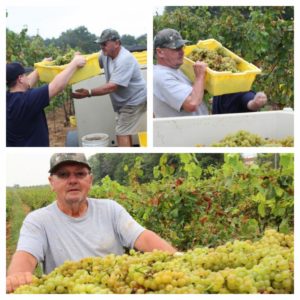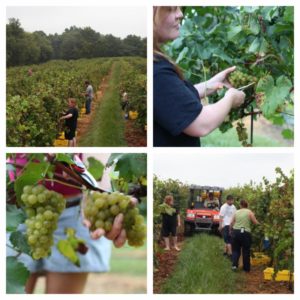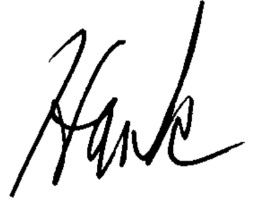Chaumette October News: Letter from Hank

A Letter From Hank
Harvest is under way. As of today, we have picked all of the Chardonel. The quantity was slightly less than what we estimated initially, but the quality is fantastic. Several things were done a little differently this year; one is that Mark used a different “juicing enzyme.” When the grapes come in from the field, we douse them with a natural enzyme to make the grapes give up their juice more easily when they are pressed, a standard wine industry practice. Mark switched enzymes with our yeast supplier this year to a newly-offered one.
Our procedure after pressing the grapes is to put the new juice in our temperature controlled tanks, turn on the cold and drop the temperature to below 50 degrees Fahrenheit. Within 24 hours, a layer of solids falls out of the new juice. In past years, that layer was 8 or so inches thick, and the juice remained cloudy, which is fairly standard. This year, the layer in the tank wasonly about 2 inches thick, and the juice was clear ~ atogether different from previous years. We are very pleased with the taste of the juice, as it is even more complex, fresh and multi-dimensional than what we have seen before. Mark brought a glass of the new juice to my office, and it was so clear that I thought it was wine that had been filtered.Instead, it was our brand-new juice. The first vineyard block that we harvested was an area we call Thebeau I. This block was an experimental planting from about a dozen years ago in which we spaced the vines only three feet apart. In our other plantings, the vines are six feet apart with two arms spreading in opposite directions along the wire. In this closely planted vineyard, we have eliminated one of the arms, called cordons. The result is the plant has only half the amount of fruit to ripen and can devote its full energy to the smaller crop. This was the case with our Thebeau I planting. We harvested it first, because its fruit was further along in the ripening process than any other part of the vineyard.
The first vineyard block that we harvested was an area we call Thebeau I. This block was an experimental planting from about a dozen years ago in which we spaced the vines only three feet apart. In our other plantings, the vines are six feet apart with two arms spreading in opposite directions along the wire. In this closely planted vineyard, we have eliminated one of the arms, called cordons. The result is the plant has only half the amount of fruit to ripen and can devote its full energy to the smaller crop. This was the case with our Thebeau I planting. We harvested it first, because its fruit was further along in the ripening process than any other part of the vineyard.
 Another interesting difference that we had this year occurred in the block we call our Old Vineyard. This was the first block that we planted in 1992. We noticed that there was a marked difference in color between the top front of the cluster, fully exposed to the sun, and the back side of the cluster facing the inner part of the vine. The front top berries measured 27 brix, while the interior shaded berries measured 21 brix. This is the first time we have seen a variation this large. Bear in mind both grapes go into our press, and about the same amount of juice is extracted from each. In the case of the old vineyard, the final brix reading was 24.8. Brix is a measure of soluble solids in the juice of which sugars constitute 98 or 99%.
Another interesting difference that we had this year occurred in the block we call our Old Vineyard. This was the first block that we planted in 1992. We noticed that there was a marked difference in color between the top front of the cluster, fully exposed to the sun, and the back side of the cluster facing the inner part of the vine. The front top berries measured 27 brix, while the interior shaded berries measured 21 brix. This is the first time we have seen a variation this large. Bear in mind both grapes go into our press, and about the same amount of juice is extracted from each. In the case of the old vineyard, the final brix reading was 24.8. Brix is a measure of soluble solids in the juice of which sugars constitute 98 or 99%.
 Still another difference we experienced this year was the use of some newly released yeasts. The new yeasts are more efficient at converting sugar to alcohol. In prior years, we have used a factor of .57 times the brix, which equals about the amount of alcohol that will be expected in the wine. For the new, more efficient yeasts, we have found that we need to use a factor of .60 to accurately predict the amount of alcohol to expect. It will yield a fuller-bodied wine with greater mouthfeel ~ attributes we strive for. We have also harvested the Traminette,and we’ll start on the Chambourcin in a week or so. We believe the Nortons will be ripe in mid-October.On a completely different subject, I am delighted to announce that we have now installed a new booking engine for villas rentals. The new engine shows you a calendar of days that we are not sold out and then another screen with which villas happen to be available on that day. It goes on to provide a description of the villas that are available, and in the near future we will be uploading pictures of both the insides of the villas and the views from the villa porches. We think this will greatly simplify shopping for a villa stay. We are also in the process of simplifying the path to get to the booking engine. In the near future, we will have a way to go directly to our home page to the booking engine.
Still another difference we experienced this year was the use of some newly released yeasts. The new yeasts are more efficient at converting sugar to alcohol. In prior years, we have used a factor of .57 times the brix, which equals about the amount of alcohol that will be expected in the wine. For the new, more efficient yeasts, we have found that we need to use a factor of .60 to accurately predict the amount of alcohol to expect. It will yield a fuller-bodied wine with greater mouthfeel ~ attributes we strive for. We have also harvested the Traminette,and we’ll start on the Chambourcin in a week or so. We believe the Nortons will be ripe in mid-October.On a completely different subject, I am delighted to announce that we have now installed a new booking engine for villas rentals. The new engine shows you a calendar of days that we are not sold out and then another screen with which villas happen to be available on that day. It goes on to provide a description of the villas that are available, and in the near future we will be uploading pictures of both the insides of the villas and the views from the villa porches. We think this will greatly simplify shopping for a villa stay. We are also in the process of simplifying the path to get to the booking engine. In the near future, we will have a way to go directly to our home page to the booking engine.Lastly, here is an interesting story from the St. Louis Business Journal covering the Missouri wine industry’s grape harvest this year, featuring Chaumette! Here is a link to the article.




+ There are no comments
Add yours